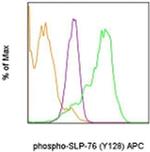Search Thermo Fisher Scientific
Invitrogen
Phospho-SLP-76 (Tyr128) Monoclonal Antibody (HNDZ55), APC, eBioscience™
FIGURE: 1 / 1
Phospho-SLP-76 (Tyr128) Antibody (17-9037-42) in Flow

Product Details
17-9037-42
Species Reactivity
Host/Isotype
Recommended Isotype Control
Class
Type
Clone
Conjugate
Excitation/Emission Max
Form
Concentration
Purification
Storage buffer
Contains
Storage conditions
Shipping conditions
RRID
Product Specific Information
Description: This HNDZ55 monoclonal antibody recognizes human SH2 domain-containing leukocyte protein of 76 kD (SLP-76) when phosphorylated on tyrosine 128 (Y128). SLP-76 is phosphorylated by ZAP-70 downstream of the T cell receptor (TCR). SLP-76 contains an acidic region that includes a PEST domain, several tyrosine residues that are phosphorylated following TCR ligation, a proline-rich domain, and an SH2 domain. Numerous proteins associate with SLP-76 including Vav1, GADS, and PLC gamma 1, supporting the notion that SLP-76 functions as a critical adaptor protein downstream of the TCR. SLP-76-deficient T cell lines or mice deficient in SLP-76 have shown that SLP-76 plays a positive role in promoting T cell development and activation as well as mast cell and platelet function.
This antibody recognizes only human SLP-76 when phosphorylated on Y128. It is not recommended for staining of mouse cells.
Applications Reported: This HNDZ55 antibody has been reported for use in intracellular staining followed by flow cytometric analysis.
Applications Tested: This HNDZ55 antibody has been pre-titrated and tested by intracellular staining followed by flow cytometric analysis of stimulated normal human peripheral blood cells. This can be used at 5 µL (0.5 µg) per test. A test is defined as the amount (µg) of antibody that will stain a cell sample in a final volume of 100 µL. Cell number should be determined empirically but can range from 10^5 to 10^8 cells/test.
Staining Protocol: Protocol A and Protocol C are recommended for this monoclonal antibody. Use of Protocol A: Two-step protocol: intracellular (cytoplasmic) proteins allows for the greatest flexibility for detection of surface and intracellular (cytoplasmic) proteins. Protocol C: Two-step protocol: Fixation/Methanol allows for the greatest discrimination of phospho-specific signaling between unstimulated and stimulated samples, but with limitations on the ability to stain specific surface proteins (refer to "Clone Performance Following Fixation/Permeabilization" located in the Best Protocols Section under the Resources tab online). All Protocols can be found in the Flow Cytometry Protocols: "Staining Intracellular Antigens for Flow Cytometry Protocol" located in the Best Protocols Section under the Resources tab online.
Excitation: 633-647 nm; Emission: 660 nm; Laser: Red Laser.
Filtration: 0.2 µm post-manufacturing filtered.
Target Information
SLP-76 was originally identified as a substrate of the ZAP-70 protein tyrosine kinase following T cell receptor (TCR) ligation in the leukemic T cell line Jurkat. The SLP-76 locus has been localized to human chromosome 5q33 and the gene structure has been partially characterized in mice. The human and murine cDNAs both encode 533 amino acid proteins that are 72% identical and comprised of three modular domains. The NH2-terminus contains an acidic region that includes a PEST domain and several tyrosine residues which are phosphorylated following TCR ligation. SLP-76 also contains a central proline-rich domain and a COOH-terminal SH2 domain. A number of additional proteins have been identified that associate with SLP-76 both constitutively and inducibly following receptor ligation, supporting the notion that SLP-76 functions as an adaptor or scaffold protein. Studies using SLP-76 deficient T cell lines or mice have provided strong evidence that SLP-76 plays a positive role in promoting T cell development and activation as well as mast cell and platelet function.
For Research Use Only. Not for use in diagnostic procedures. Not for resale without express authorization.
How to use the Panel Builder
Watch the video to learn how to use the Invitrogen Flow Cytometry Panel Builder to build your next flow cytometry panel in 5 easy steps.
References (0)
Bioinformatics
Protein Aliases: 76 kDa tyrosine phosphoprotein; Lymphocyte cytosolic protein 2; lymphocyte cytosolic protein 2 (SH2 domain containing leukocyte protein of 76kDa); SH2 domain-containing leukocyte protein of 76 kDa; SH2 domain-containing leukocyte protein of 76kD; SLP-76 tyrosine phosphoprotein; SLP76
Gene Aliases: LCP2; SLP-76; SLP76
UniProt ID: (Human) Q13094
Entrez Gene ID: (Human) 3937

Performance Guarantee
If an Invitrogen™ antibody doesn't perform as described on our website or datasheet,we'll replace the product at no cost to you, or provide you with a credit for a future purchase.*
Learn more
We're here to help
Get expert recommendations for common problems or connect directly with an on staff expert for technical assistance related to applications, equipment and general product use.
Contact tech support

